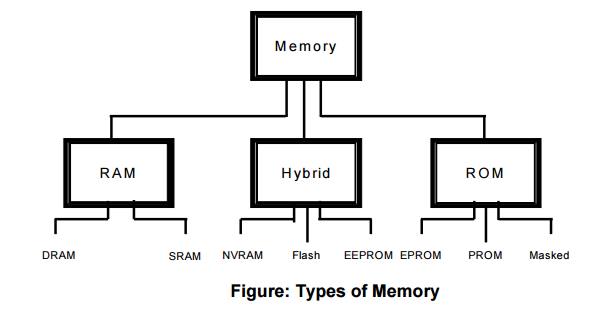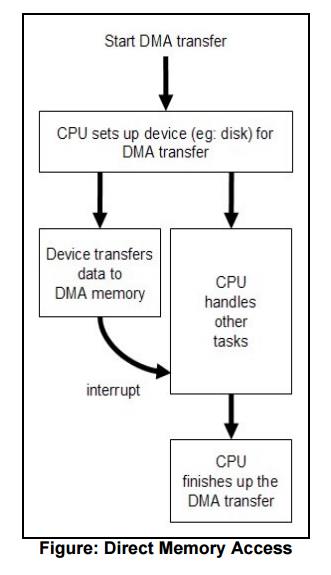Chapter: Embedded Systems
Embedded Systems: Memory
Embedded
Systems: Memory
Unit
Structure
Objectives
1. Introduction
2. Types of Memory
3. Types of RAM
SRAM
DRAM
4. Types of ROM
MASKED
PROM
EPROM
5. Types of Hybrid Memory
NVRAM
FLASH
EEPROM
6. DIRECT MEMORY ACCESS (DMA)
OBJECTIVES
After reading this chapter you will understand:
Different
types of memory available
Types of
RAM
Types of
ROM
Types of
Hybrid Memory
1. INTRODUCTION
There are different types of memories available
to be used in computers as well as embedded system.
This chapter guides the reader through the
different types of memories that are available and can be used and tries to
explain their differences in simple words.
2
TYPES OF MEMORY
There are three main types of memories, they are
RAM (Random Access Memory)
It is read
write memory.
Data at
any memory location can be read or written.
It is
volatile memory, i.e. retains the contents as long as electricity is supplied.
Data
access to RAM is very fast
ROM (Read Only Memory)
It is read
only memory.
Data at
any memory location can be only read.
It is
non-volatile memory, i.e. the contents are retained even after electricity is switched
off and available after it is switched on.
Data
access to ROM is slow compared to RAM
HYBRID
It is
combination of RAM as well as ROM
It has
certain features of RAM and some of ROM
Like RAM
the contents to hybrid memory can be read and written
Like ROM
the contents of hybrid memory are non volatile
The following figure gives a classification of
different types of memory

3
TYPES OF RAM
There are 2 important memory device in the RAM family.
SRAM (Static RAM)
DRAM (Dynamic RAM)
SRAM
(Static RAM)
It retains the content
as long as the power is applied to the chip.
If the power is turned
off then its contents will be lost forever.
DRAM
(Dynamic RAM)
DRAM has extremely
short Data lifetime(usually less than a quarter of second). This is true even
when power is applied constantly.
A DRAM controller is
used to make DRAM behave more like SRAM.
The DRAM controller
periodically refreshes the data stored in the DRAM. By refreshing the data
several times a second, the DRAM controller keeps the contents of memory alive
for a long time.
4
TYPES OF ROM
There are three types of ROM described as
follows:
Masked ROM
These are
hardwired memory devices found on system.
It
contains pre-programmed set of instruction and data and it cannot be modified
or appended in any way. (it is just like an Audio CD that contains songs
pre-written on
it and
does not allow to write any other data)
The main
advantage of masked ROM is low cost of production.
PROM
(PROGRAMMABLE ROM )
This
memory device comes in an un-programmed state i.e. at the time of purchased it
is in an un-programmed state and it allows the user to write his/her own
program or code into this ROM.
In the
un-programmed state the data is entirely made up of 1’s.
PROMs are
also known as one-time-programmable (OTP) device because any data can be
written on it only once. If the data on the chip has some error and needs to be
modified this memory chip has to be discarded and the modified data has to be
written to another new PROM.
EPROM
(ERASABLE-AND-PROGRAMABLE ROM)
It is same
as PROM and is programmed in same manner as a PROM.
It can be
erased and reprogrammed repeatedly as the name suggests.
The erase
operation in case of an EPROM is performed by exposing the chip to a source of
ultraviolet light.
The reprogramming ability makes EPROM as
essential part of software development and testing process.
5
TYPES OF HYBRID MEMORY
There are three types of Hybrid memory devices:
EEPROMs
EEPROMs
stand for Electrically Erasable and Programmable ROM.
It is same
as EPROM, but the erase operation is performed electrically.
Any byte
in EEPROM can be erased and rewritten as desired
Flash
Flash
memory is the most recent advancement in memory technology.
Flash
memory devices are high density, low cost, nonvolatile, fast (to read, but not
to write), and electrically reprogrammable.
Flash is
much more popular than EEPROM and is rapidly displacing many of the ROM devices.
Flash
devices can be erased only one sector at a time, not byte by byte.
NVRAM
NVRAM is
usually just a SRAM with battery backup.
When power
is turned on, the NVRAM operates just like any other SRAM but when power is
off, the NVRAM draws enough electrical power from the battery to retain its
content.
NVRAM is
fairly common in embedded systems.
It is more
expensive than SRAM.
6. DIRECT
MEMORY ACCESS (DMA)
DMA is a technique for transferring blocks of
data directly between two hardware devices.
In the absence of DMA the processor must read
the data from one device and write it to the other one byte or word at a time.
DMA Absence Disadvantage: If the amount of data
to be transferred is large or frequency of transfer is high the rest of the
software might never get a chance to run.
DMA Presence Advantage: The DMA Controller
performs entire transfer with little help from the Processor.
Working of DMA
The
Processor provides the DMA Controller with source and destination address &
total number of bytes of the block of data which needs transfer.
After
copying each byte each address is incremented & remaining bytes are reduced
by one.
When
number of bytes reaches zeros the block transfer ends & DMA Controller
sends an Interrupt to Processor.

Related Topics